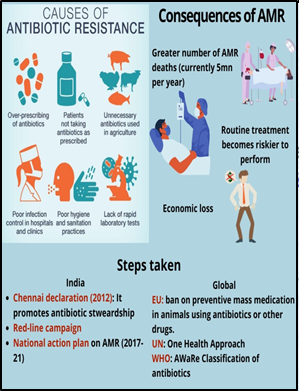“WHO LISTS NEW PRIORITY PATHOGENS FOR SURVEILLANCE”
Why in the news?
- The WHO’s updated priority pathogens list includes over 30 threats, highlighting ongoing global health concerns.
- Recent outbreaks of Nipah and Zika underscore the need for enhanced surveillance.
 source:medium
source:medium
WHO’s Priority Pathogens List:
- Global Health Update:
- COVID-19 remains a concern with recent reports of over 40 athletes testing positive at the 2024 Olympics in Paris.
- The World Health Organization (WHO) has updated its list of “priority pathogens,” highlighting the need for ongoing vigilance and research.
- Pathogens on the Priority List:
- The WHO’s updated list includes over 30 pathogens, evaluated by 200 scientists from 54 countries.
- Notable pathogens include Nipah virus, Ebola, Zika virus, dengue, and influenza A viruses.
- New additions among bacteria include those causing plague, cholera, pneumonia, dysentery, and non-typhoidal salmonella.
- Regional Concerns and Surveillance:
- In India, Nipah virus has caused recent fatalities, and Zika virus cases are rising in Maharashtra.
- The report emphasises the need for surveillance of pathogens to monitor their spread, virulence, and resistance to treatment.
- Bacterial pathogens, especially in Southeast Asia, are also highlighted for their potential health impacts.
| Critical Priority Pathogens:
Definition:
- Bacteria that pose major global health threats due to their resistance to current treatments.
- They can transfer their resistance genes to other bacteria.
WHO’s Updated List:
- The World Health Organization (WHO) has revised its Bacterial Pathogens Priority List (BPPL).
- Includes 15 families of antibiotic-resistant bacteria.
- Pathogens are categorised into critical, high, and medium priority groups to guide response efforts.
High Burden in Regions:
- Certain high-priority pathogens, such as Salmonella and Shigella, are prevalent in low- and middle-income countries.
- These pathogens present significant challenges in healthcare settings.
Antibiotic Resistance:
- Includes gram-negative bacteria resistant to last-resort antibiotics.
- Mycobacterium tuberculosis strains resistant to Rifampicin, a crucial antibiotic, are also noted.
Antimicrobial Resistance (AMR):
- AMR occurs when pathogens no longer respond to medicines.
- Causes include misuse and overuse of antimicrobials.
Challenges:
- Pathogens like antibiotic-resistant Neisseria gonorrhoeae and Enterococcus faecium cause persistent infections.
- They show resistance to multiple antibiotics, requiring focused research and public health interventions.
WHO Bacterial Priority Pathogens List (BPPL) 2024:
Purpose: The 2024 WHO BPPL is a key tool in combating antimicrobial resistance (AMR) globally, guiding research and development for new antibiotics.
Updates:
- Replaces the 2017 edition.
- Expands the list to 24 antibiotic-resistant bacterial pathogens.
- Updates rankings to address evolving threats from antibiotic resistance.
Bacterial Pathogens Priority List (BPPL) Overview:
- Purpose: Guides global efforts against antimicrobial resistance (AMR) by prioritising research and development (R&D) for new antibacterials.
Background:
- First developed by WHO in 2017 with 13 pathogens listed.
- Utilises multi-criteria decision analysis (MCDA) for systematic evaluation.
2024 Update:
- Includes 24 pathogens across 15 families.
- Categorised into critical, high, and medium priority groups.
Significance:
- Directs R&D investments, informs public health strategies, and engages stakeholders in AMR initiatives.
Associated Article:
https://universalinstitutions.com/who-warns-critical-priority-pathogens-pose-an-escalating-global-health-threat/ |
source:medium




